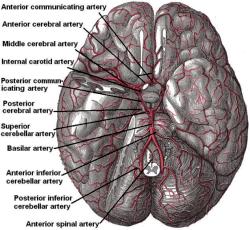Basilar Artery Migraines (BAM)
In the last few years, our understanding of what have been called basilar artery migraines has drastically increased. Still, there's a lot of mystery in this type of migraine with the strange symptoms.
Basilar artery migraines have been known by several names, including basilar migraine headache, basilar migraine, vertebrobasilar migraine, Bickerstaff's Migraine, and syncopal migraine. Today it's properly known as basilar-type migraine. Why the change?
To skip ahead to symptoms and treatment of basilar migraine, click here.
A little history
A neurologist from Wales, by the name of Dr. Edwin Robert Bickerstaff, had a surprise. Over a fairly short period of time, he saw two patients with almost identical symptoms. That in itself wasn't unusual - the unusual part was that the symptoms were baffling. A young teenager and and older man both had symptoms that seemed related to the basilar artery, a major artery which supplies blood to the brain. And so this strange type of migraine became known as Bickerstaff's migraine, or basilar artery migraine.
It was in 1961 that Dr. Bickerstaff first introduced basilar artery migraines to the world as a specific diagnosis.
As Dr. Bickerstaff's research continued, he at noticed that a lot of young girls had this type of migraine. Research today suggests that this migraine type actually has a similar ratio to other types of migraine (roughly 3 women to 1 man), though we still suspect that there may be higher incidence in young adults. In some patients, attacks decrease as they go into their 20s and 30s.
Typical symptoms included vertigo, unsteadiness, pins and needles, temporary blindness and even impairment of consciousness. Obviously very frightening and disabling!
The early theory was that spasms in the basilar artery were at the root of the basilar artery migraines. This fit with the theory at the time that somehow the blood vessels and arteries were causing the strange migraine symptoms.
Modern research
Today we have more ability than ever to "see" what's happening in the body, particularly in the brain. We've had to back away from the idea that migraine is some kind of vascular headache. Instead, it looks like migraine in general is a disease that has its roots in the brain, particularly in the brain stem.
This is the case with basilar artery migraine, and the reason why the name is being revised to basilar-type migraine. After monitoring the basilar artery in many patients, it looks like some kind of artery spasm is not common to patients.
So the name has been changed, and specialists diagnose basilar-type migraine based on symptoms and ruling out other conditions. We're still learning exactly why some people have these symptoms, and what can be done to stop them.
Read more about basilar-type migraine (BTM) symptoms and treatment here.
Keep up with the latest research on headache and migraine conditions at the Headache and Migraine News Blog!
References: Bonica's Management of Pain on basilar artery migraines, edited by by John D. Loeser, Steven H. Butler, C. Richard Chapman, PhD Dennis C. Turk (2001); Telegraph obituary of Edwin Bickerstaff (2008); IHS Classification ICHD-II on Basilar-type migraine (2005)
Enjoy this page? Please pay it forward. Here's how...
Would you prefer to share this page with others by linking to it?
- Click on the HTML link code below.
- Copy and paste it, adding a note of your own, into your blog, a Web page, forums, a blog comment,
your Facebook account, or anywhere that someone would find this page valuable.
